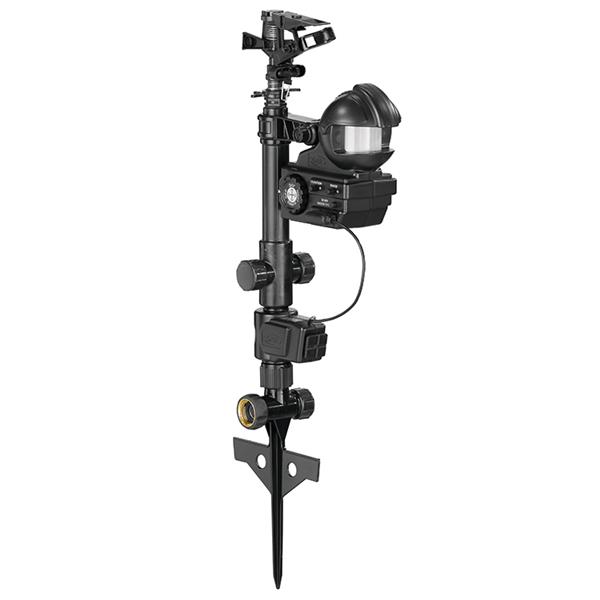How To Keep Cats And Dogs Out Of Garden
It is a wonderful feeling to have a garden that is the envy of your friends, family and neighbors – a garden that is your pride and joy. Creating this masterpiece garden was hard work. There’s pruning, planting, sowing, mowing, raking, watering and digging to do but having completed all this, your favorite thing to do now is wake up in the mornings, go outside and look in wonder at your beautiful cottage garden with its jumble of perennials and shrubs. But wait….what is up with the broken stems of flowers, the disturbed soil, paw prints, and what looks like fur balls in the soil… (cue disaster music and swear words)… the realisation is sinking in… that disturbed soil with hovering flies is covering something smelly. It looks like grumpy cat from next door is making your garden his new litter box.
So, what do we do and where do we go from here… how do we keep this cat out of the garden? Is there a product or produce that will not harm the animal but cease the behavior?
Here are a number of suggestions to solve your problem puss in boots… or in this case puss in garden.
Changing the Texture and Plant Structure of Your Garden
Cats love the texture of dirt – on occasion, they are known to eat it. The loose soil is easy for the cat to dig and cover. Also, tall plants or perennials provide some camouflage. So, you really can’t blame the cat for choosing such an ideal place but still, it’s not the spot you want them leaving “presents” for you to find.
Bark or mulch covering the soil is a common tactic. It is a harsher texture and isn’t particular appealing to cats due to the impact and roughness on their paws – it isn’t smooth and soft as freshly toiled soil. Consumers have had success with the FibreDust CoCo Mulch or Bonsai Pine Bark. Both options offer great garden coverage and water retention. The downside is that some cats prefer the bark or mulch to the soil.
Rocks or pebbles can be a great alternative if you do not like the look of bark or mulch – there are a variety of colors available. Cats do not like the hardness of the pebbles or rocks. Also, in summer, if you live in a tropical or hot environment, rocks and stones can heat up very quickly – cats do not like the heat on their paws. Why not try the polished gravel look on your garden bed.
A more popular and promising product available is the spiked mat – a coil/mat of mesh with spikes. No harm will come to puss. Cats do not like walking on the spiked mats so they will tend to avoid the area at all cost.
If you are working on a strict budget or are concerned with costs, there is the option to place items such as pinecones and egg shells into the soil as well as branches in the garden. If you find that this is not working, Orange Oil is a citrus spray that is used in keeping smaller pests out of your garden and is a fantastic deterrent – cats detest citrus smelling sprays and oils. Orange oil is readily available in concentrate making this a dual action and cost effective way to stop cats in their tracks and make your garden look superb.
There are a large array of plants that you can add throughout your garden space that will stop cats from visiting the area. As puss has a keen sense of smell, plants such as rue, lavender, lemon thyme, pennyroyal and coleus canina will drive him away (he will run faster than a toupee in a hurricane).
Stopping Them in Their Tracks Based on Smell
As previously mentioned, cats do have a very keen sense of smell. It is proven that their nose is the most important organ – this makes perfect sense in the animal kingdom and the act of survival in the wild. In the kingdom of humans and their gardens, a sure-fire repellent on the market and gaining momentum is Nature’s Mace Cat mace creates a sensory barrier that works by attacking a cats sense of smell and taste.
As we know, cats do no not like the smell of citrus. It turns them off pretty quickly – kind of like children who turn their noses up at the smell of certain vegetables. Why not gather some citrus peels and place them around the edge of your garden. As discussed above, try a citrus based spray such as orange oil or make your own by cutting up some old oranges (as well as the peels) and placing into a litre of water. Get yourself a spray bottle, fill and you have made yourself a homemade environmentally-friendly cat repellent.
There are a number of natural scents and granular repellents available – I have found that using cayenne pepper, black pepper, dry mustard powder, or turmeric is not a healthy option for deterring the fur-faced variety. The aforementioned powders will get on the cats’ paws. The cat will lick their paws. In turn, the cat uses it’s paws to clean eyes and ears and other orifices which shall not be named. This will cause burns and irritation which could lead to infection. No one wants to see an animal in distress.
Certain granular repellents on the market promise success – a minority of granules contain a peppermint scent. What most people don’t know is that cats love peppermint. Cats plus peppermint equals flirty time. So please, do not buy any peppermint flavored cat repellent – it will not work – you will just have a very happy, purring, playful cat sunning itself in your garden bed. There are good granular repellents out there, you just need to do your research and find what is right for you. Just be mindful of cost as granular repellents need to be replaced fairly regularly.
Technology and Deterring Cats in Your Garden
If you are finding that none of the above suggestions are working effectively, then you need to turn to technology to satisfy your requirements. There are a number of motion sensor sprinklers, motion detection sprinklers, and solar ultrasonic detectors on the market that are effective, with positive reviews by consumers.
Below are my product recommendations using technology to deter cats in your garden.
The PredatorGuard PestAway Ultrasonic Cat Repellent scares cats away with a motion activated blast of ultrasonic sound and strobe lights. Simply place predator guard in your desired location, and watch as unwanted cats are deterred from entering the 40 foot (12 meter) range of protection. As soon as the cat enters this area, the unit emits an ultrasonic frequency (only audible to animals) and flashes ultra-bright strobe lights to effectively scare fur-face away.
One of the best sellers on the market is the Costway Scarecrow Motion Activated Animal Repellent. The ScareCrow is a motion-activated repellent that sprays a burst of water when it senses an intruder. This is a great unit for keeping cats away from your garden. The ScareCrow startles by emitting a loud clicking noise and sprays a harmless burst of water. A single unit can protect up to 1,200 sq. feet, and uses a single nine-volt battery. You can stack ScareCrow sprinklers in each corner of your property to fully protect your garden. The repellent uses about two to three cups of water per burst, and has the added bonus of watering your garden and lawn.
I love the ScareCrow because it’s 100% safe and a great alternative to chemical products. It also serves a dual purpose (whose garden couldn’t use a little extra watering), and also deters cats. If you’re looking for a cost-effective, reliable product to keep cats out of your lawn and garden, the ScareCrow is my top choice.
Another fantastic option for consumers is the Wonninek Solar Animal Repeller. The Wonninek is solar powered, is user and human friendly with no harsh chemicals or pesticides being used. The unit emits an ultrasonic sound when the fur intruder is detected. It is also equipped with an alarm and powerful flashing LED lights. There are a range of different frequencies and sensitivity modes that you can choose and the motion sensor detects movement within a 110 degree arc and at a distance of up to 8 meters. Like the scarecrow, it is 100% safe for the family to use and has the dual purpose of watering and deterring.
Talk to Your Neighbor
If you know who owns the fur intruder in your garden, why not approach your neighbor in a friendly manner and let them know of your concerns. This might sound like a scary prospect but perhaps your neighbor needs to know the dangers their cat may be in (curfew/dangers on the road, wild animals, or other people may not be so understanding and trap the animal) and the impact the animal is having on your life, your happiness and your garden. Let your neighbor know the dangers of cat faeces and the diseases that can be spread to humans, let alone the destruction that is caused to the garden bed and wildlife in the area. Provide solutions to the problem – suggest assistance in construction of a cat enclosure such as the Paw Hut or ask the neighbor if the cat can be kept indoors with cat litter as an option. It really is in the best interests of the cat to explore this friendly option with your neighbor.
By reading through my review, you should now have a general overview of ideas to deter cats in your garden and the variety of cat repellents on the market and which one you might consider purchasing. Good luck on your quest!








There are no comments yet, add one below.